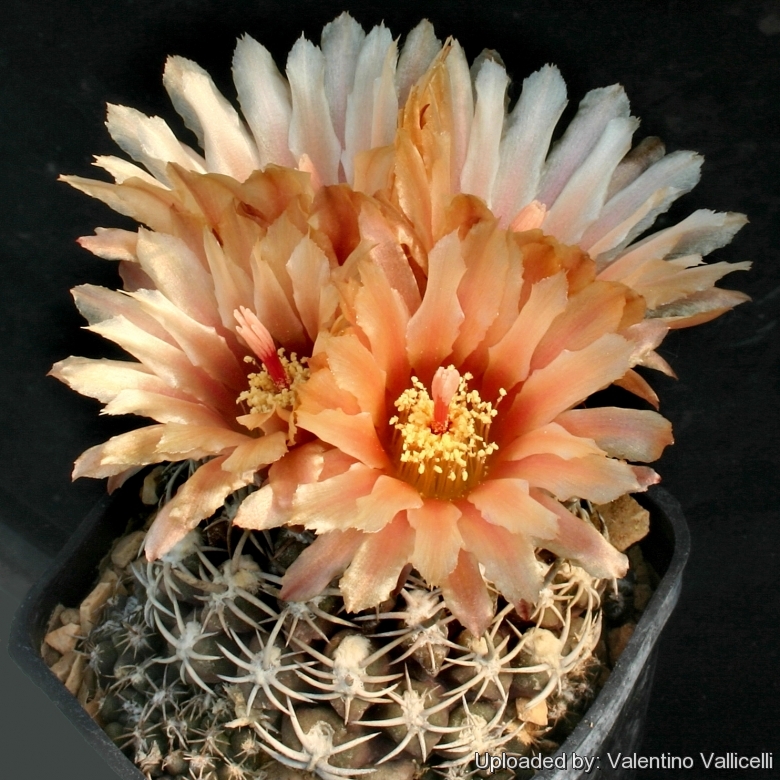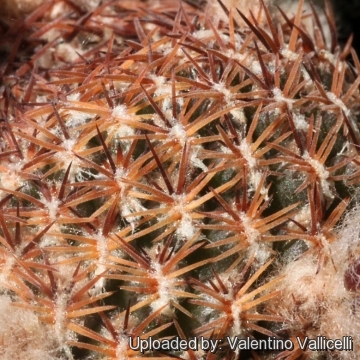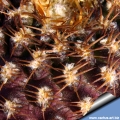Accepted Scientific Name: Eriosyce aerocarpa (F.Ritter) Katt.
119 (1994)

Neochilenia acrocarpa (Eriosyce aerocarpa) Photo by: Valentino Vallicelli
It is difficult to take good pictures of this plant because the petals are translucent and some colours are not captured well by digital cameras.
Origin and Habitat: Chile, Atacama, Huasco (Around Carrizal Bajo at west of Canto del Agua )
Habitat: Grows in some extremely arid areas in the Atacama desert, in superficial soils covered with quartz, and then the sand sustain the roots or in rocky quebradas deep seated in rock crevices. They cohabit with Eriosyce napinaSN|2370]]SN|2370]] ssp. Challensis
Synonyms:
See all synonyms of Eriosyce aerocarpa
back
Accepted name in llifle Database:Eriosyce aerocarpa (F.Ritter) Katt.119 (1994)Synonymy: 12
back
Description: It is a small geophytic cactus with a dark body and very short pectinated spines.
Stem: Flattened, globose to short cylindrical, brown or grey-greenish with a reddish-violet nuance. 2-4 cm in diameter but in culture it grows slowly more than 7 cm tall and about 7 cm in diameter.
Ribs: Several, spiralling and disappearing into tubercles.
Radial spines: 6-10(-14) short, about 2-3(-5) mm long, more or less pectinated, needle like, straight to somewhat curved against to the stem yellow-orangish to dark reddish-brow that turn to grey as they age.
Central spines: 0-1(-2). Thick, erect up to 10 mm long.
Roots: It has a large, conical taproot.
Flowers: Born on young areoles, 3-5 cm wide, cream white to dirty orangish or reddish with darker midline. The flowers have a beautiful silky shine, the tube is covered in thin brown hairs.
Fruits: Elongate, dehiscing by a basal pore.
 Neochilenia acrocarpa (Eriosyce aerocarpa) Photo by: Valentino Vallicelli
Neochilenia acrocarpa (Eriosyce aerocarpa) Photo by: Valentino Vallicelli Neochilenia acrocarpa (Eriosyce aerocarpa) Photo by: Valentino Vallicelli
Neochilenia acrocarpa (Eriosyce aerocarpa) Photo by: Valentino Vallicelli Neochilenia acrocarpa (Eriosyce aerocarpa) Photo by: Valentino Vallicelli
Neochilenia acrocarpa (Eriosyce aerocarpa) Photo by: Valentino Vallicelli Neochilenia acrocarpa (Eriosyce aerocarpa) Photo by: Cactus Art
Neochilenia acrocarpa (Eriosyce aerocarpa) Photo by: Cactus Art Neochilenia acrocarpa (Eriosyce aerocarpa) Photo by: Valentino Vallicelli
Neochilenia acrocarpa (Eriosyce aerocarpa) Photo by: Valentino Vallicelli Locality: Freirina (Eriosyce aerocarpa) Photo by: Valentino Vallicelli
Locality: Freirina (Eriosyce aerocarpa) Photo by: Valentino Vallicelli Neochilenia acrocarpa (Eriosyce aerocarpa) Photo by: Valentino Vallicelli
Neochilenia acrocarpa (Eriosyce aerocarpa) Photo by: Valentino Vallicelli Neochilenia acrocarpa (Eriosyce aerocarpa) Photo by: Valentino Vallicelli
Neochilenia acrocarpa (Eriosyce aerocarpa) Photo by: Valentino VallicelliCultivation and Propagation: It is a summer-growing species of relatively easy cultivation. This plant is extremely xerophytic and adapted to very dry soils. It has a thick taproot and is susceptible to over-watering if kept in a non ventilated place. This cactus continues to be, a particular prize among collectors.
Growth rate: Slow-growing.
Soil: Grow it in an open mineral, sandy-gritty cactus compost and provide a very good drainage. It needs deep pots to accommodate its taproot.
Exposure: It is suited for sunny-brightly exposure; can tolerate light shade and has a good heat tolerance. But it will do its best only with lots of sun and become stressed with inadequate light which could result in poor growth and unnatural shape.
Watering: Water in moderation, it prefer a completely dry place during winter. Mature individuals easily rot and die especially after planting so be extremely cautious with watering. Keep dry in winter or when night temperatures remain below 10° C. Water it less than average if in bigger pots.
Fertilization: Feed them once during the growing season with a fertilizer specifically formulated for cactus and succulents (high potash fertilizer with a dilute low nitrogen), including all micro nutrients and trace elements diluted to ½ the strength recommended on the label. They thrive in poor soils and need a limited supplies of fertilizer to avoid the plants developing excess vegetation, which is easily attacked by fungal diseases.
Special need: It is suited for airy exposures. Provide very good ventilation. Nearly all problems occur as a result of overwatering and poor ventilation, especially when weather conditions are dull and cool or very humid. They must have very dry atmosphere.
Hardiness: It likes warmth (recommended minimum winter temperature 5° C) But plants kept perfectly dry can easily survive to winter night temperatures below 0° C.
Pests & diseases: These cacti may be attractive to a variety of insects, but plants in good condition should be nearly pest-free, particularly if they are grown in a mineral potting-mix, with good exposure and ventilation. Nonetheless, there are several pests to watch for:
- Red spiders: Red spiders may be effectively rubbed up by misting the plants from above.
- Mealy bugs: Mealy bugs occasionally develop aerial into the new leaves and flowers with disfiguring results, but the worst types develop underground on the roots and are invisible except by their effects.
- Scales, thrips and aphids: These insects are rarely a problem.
- Rot: Rot is only a minor problem if the plants are watered and “aired” correctly. If they are not, fungicides won't help all that much.
Propagation: Usually propagated from Seeds. (seldom produces offsets) or graft. The seeds can be sown in pots of fine, well-drained sandy soil, any time during the spring when temperatures are warm. Cover the seeds with a fine layer of grit and water from below with a fungicide to prevent damping off. For the 1-2 weeks cover the pots with a sheet of glass/clear perspex to keep the humidity levels high. Remove the glass and replace it with light shade-cloth and mist once or twice a day for the next two weeks after which most seeds should have germinated. From then on mistings can be reduced to every second and then every third day as the little plants grow. The seedlings should not be disturbed until they are well rooted after which they can be planted separately in small pots. Sometimes it is grafted to avoid root rot problems as plants grafted on an hardy stock are easy to grow and no special skill is required.
Your Photos

by Cactus Art

by Cactus Art

by Valentino Vallicelli

by Valentino Vallicelli

by Valentino Vallicelli























